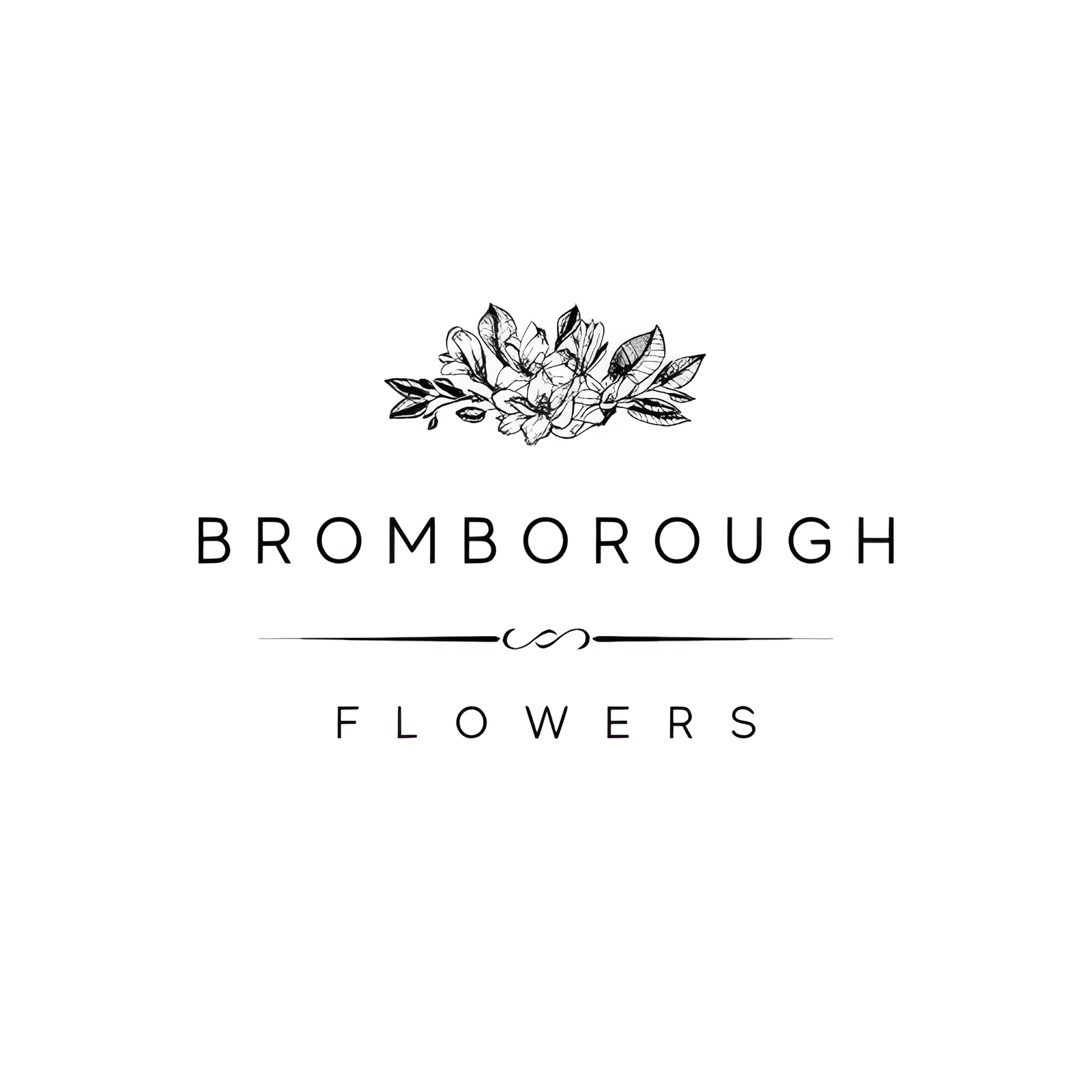Incorporating bluebells into your wedding arrangements can infuse a ceremony with a sense of timeless elegance and profound meaning. Known for their graceful, bell-shaped blooms and vibrant hues that move from delicate blue to deep violet, bluebells symbolize gratitude and everlasting love. These woodland flowers not only enhance the aesthetic appeal but also carry a sweet fragrance that adds another sensory dimension to the event. But what makes bluebells uniquely suited for weddings, and how can one effectively incorporate them into various floral designs?
Flower Overview
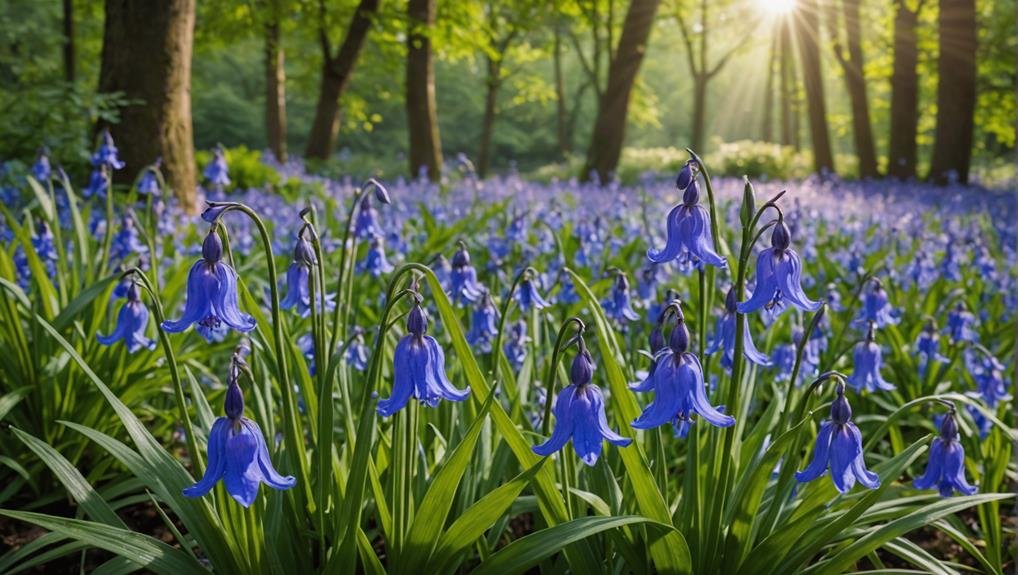
Bluebells (Hyacinthoides non-scripta) are iconic woodland flowers renowned for their striking violet-blue, bell-shaped blooms that symbolize gratitude and everlasting love. These delicate flowers, typically found in shaded, ancient woodlands, are celebrated for their vibrant hues that range from blue to purple flowers, adding a touch of charm to natural landscapes. Their unique coloration and graceful appearance have made them a favored choice for weddings and romantic occasions, where they serve as beautiful symbols of enduring affection and appreciation.
Originating from the United Kingdom, bluebells hold a special place in British cultural and natural heritage. Over half of the world's population of these flowers is found in British woodlands, making them a cherished and protected species. Their bloom period in spring transforms forest floors into a captivating sea of blue, creating a magical, fairy-tale-like atmosphere that is both visually stunning and evocative of timeless romance.
In wedding floristry, bluebells are a highly sought-after element for their natural elegance. They are frequently incorporated into bridal bouquets, centerpieces, and other floral arrangements, where their delicate blue and purple hues bring a sense of serene beauty and sophistication to any event.
Physical Description
With their slim, curving stems and dainty, hanging blooms, bluebells present a graceful and enchanting appearance. These sophisticated blooms, known scientifically as Hyacinthoides non-scripta, are a hallmark of woodland beauty, often forming dense carpets in forested areas during the spring season. The bell-shaped flowers, typically violet blue in color, hang gracefully from their stems, creating a cascading effect that enhances their visual appeal.
The physical structure of bluebells is characterized by their slender, curving stems that can reach heights of up to 30 centimeters. Each stem supports multiple flowers, which are clustered together in a one-sided arrangement, giving the plant its distinctive, drooping look. The leaves are long and slim, complementing the overall delicate appearance of the plant.
In addition to their visual appeal, bluebells are renowned for their fragrant charm. The flowers emit a sweet, subtle fragrance that is both pleasing and soothing, making them a delightful addition to any floral arrangement.
This combination of visual elegance and gentle fragrance ensures that bluebells are a popular choice for weddings, where they symbolize sincerity, gratitude, and everlasting love. Their woodland beauty and sophisticated blooms make bluebells a timeless favorite in floral design.
Available Colour Varieties
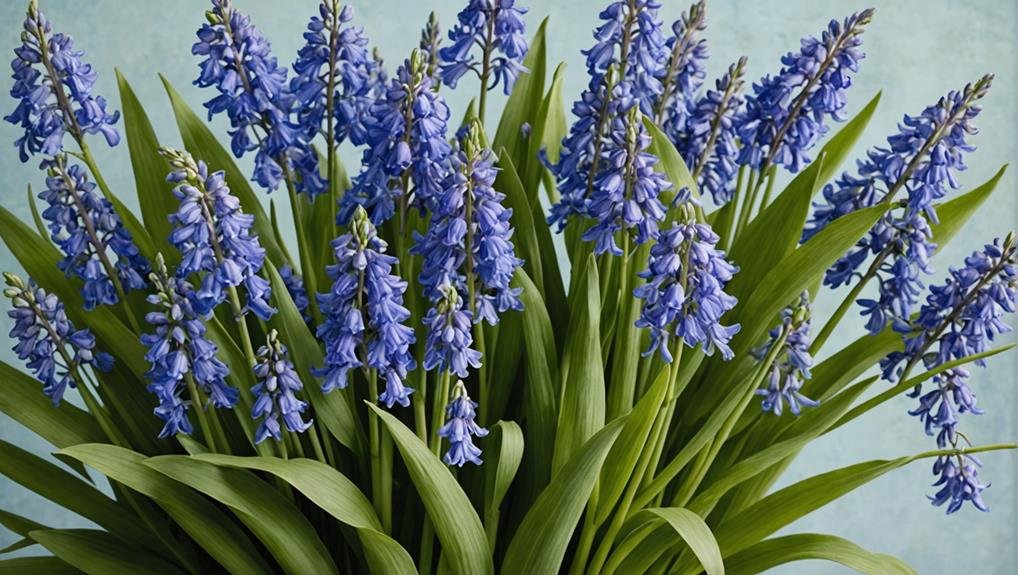
Though primarily known for their iconic violet blue hue, bluebells also come in various other subtle shades that can elevate wedding floral arrangements. These hues, ranging from pale blue to white, allow for versatile and sophisticated bouquet pairings, making bluebells suitable for diverse wedding color palettes.
When considering bluebells for your wedding, understanding their color symbolism, deeply entrenched in meanings of gratitude and everlasting love, is crucial. Their delicate appearance and flexible shades make them ideal for different floral arrangements and seasonal pairings.
To effectively integrate bluebells into your wedding decor, take into account the following:
- Bouquet pairings: Combine bluebells with other spring flowers like tulips and daisies to create a cohesive and lively bouquet.
- Floral arrangements: Incorporate bluebells into centerpieces and table settings to introduce a hint of natural beauty and sophistication.
- Wedding color palettes: Blend bluebells with pastel tones for a gentle, romantic appearance or with vibrant colors for a striking juxtaposition.
- DIY projects: Employ bluebells in handmade floral arches and garlands, ideal for adding a personal flair to your ceremony.
These adaptable flowers not only enhance the visual appeal of your wedding but also imbue your special day with significant symbolism.
Latin Name and Taxonomy
Understanding the Latin name and taxonomy of bluebells provides a deeper appreciation of their botanical heritage and distinctive qualities. Bluebells belong to the genus Hyacinthoides and are part of the Asparagaceae family. The iconic bluebell species found in the UK is scientifically known as Hyacinthoides non-scripta. These perennial bulbous plants are characterized by their long, slender leaves and drooping, bell-shaped flowers.
Taxonomically, bluebells are divided into two primary species: the native Hyacinthoides non-scripta and the Spanish bluebell, Hyacinthoides hispanica. This distinction is important for conservation efforts and habitat restoration, as hybridization between the two species can pose a threat to the genetic diversity of native bluebells. Maintaining this diversity is vital for their ecological impact, including pollinator attraction, which benefits various ecosystems.
| Species | Native Region | Key Characteristics |
|---|---|---|
| Hyacinthoides non-scripta | United Kingdom | Drooping flowers, slender leaves |
| Hyacinthoides hispanica | Spain | Upright flowers, broader leaves |
| Hybrid Bluebells | UK, Spain (crossbreed) | Mixed traits, poses a risk to genetic purity |
Understanding these distinctions not only aids in identification but also highlights the importance of preserving native species through targeted conservation strategies. This ensures that the ecological benefits, such as pollinator attraction, are maintained for future generations.
Geographical Origins
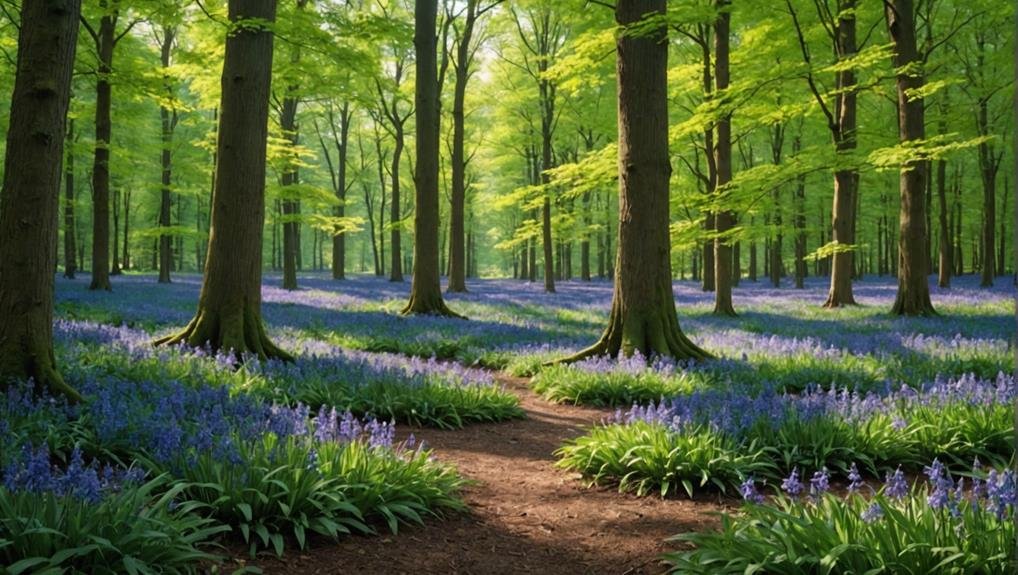
Bluebells, scientifically known as Hyacinthoides non-scripta, are indigenous to Western Europe, with a particular prevalence in the British Isles. These enchanting flowers thrive in deciduous woodlands, meadows, and hedgerows, creating a breathtaking carpet of blue in the spring. Their presence is so iconic that they are often viewed as a symbol of ancient woodlands.
The geographical origins of bluebells have important implications for their global distribution and ecological impact. While they are native to Western Europe, they have been naturalized in parts of North America, where they are equally cherished for their beauty and symbolism. However, their introduction to new environments requires careful management to avoid disrupting local ecosystems.
Conservation efforts play a pivotal role in preserving bluebells, particularly in the UK, where they are protected under the Wildlife and Countryside Act 1981 due to habitat loss and over-picking. The following points highlight key aspects of their conservation and distribution:
- Native to Western Europe, with a stronghold in the British Isles.
- Naturalized in North America, where they adapt well.
- Protected under UK laws to prevent habitat loss and over-picking.
- Important ecological impact, supporting pollinators like bees.
Understanding these elements is crucial for appreciating the bluebell's role in both natural and cultivated landscapes.
Season Availability
During the peak months of April and May, bluebells reach their full bloom, providing a magnificent seasonal display in woodlands and gardens. These iconic violet-blue flowers are highly sought after for their captivating beauty and the striking carpets of blue they create in natural settings. Their limited availability during this brief window makes them a prized addition to springtime weddings and events.
Bluebell symbolism often conveys themes of modesty and appreciation, making them a meaningful choice for wedding bouquets. A bluebell bouquet can add a touch of refinement and a sense of connection to nature, enhancing the overall aesthetic of a springtime ceremony. Their delicate appearance and soft coloring blend seamlessly with other floral varieties, offering versatility in floral arrangements.
For those looking to capture the fleeting beauty of bluebells, there are several bluebell photography tips to keep in mind. Ideal lighting conditions occur during early morning or late afternoon, when the sunlight is diffused, and shadows are softer.
Photographers should aim to capture the extensive carpets of bluebells from a low angle to emphasize their density and create a more immersive visual experience. Whether for personal enjoyment or professional projects, bluebells offer unparalleled opportunities for stunning photographic compositions.
Growing Conditions
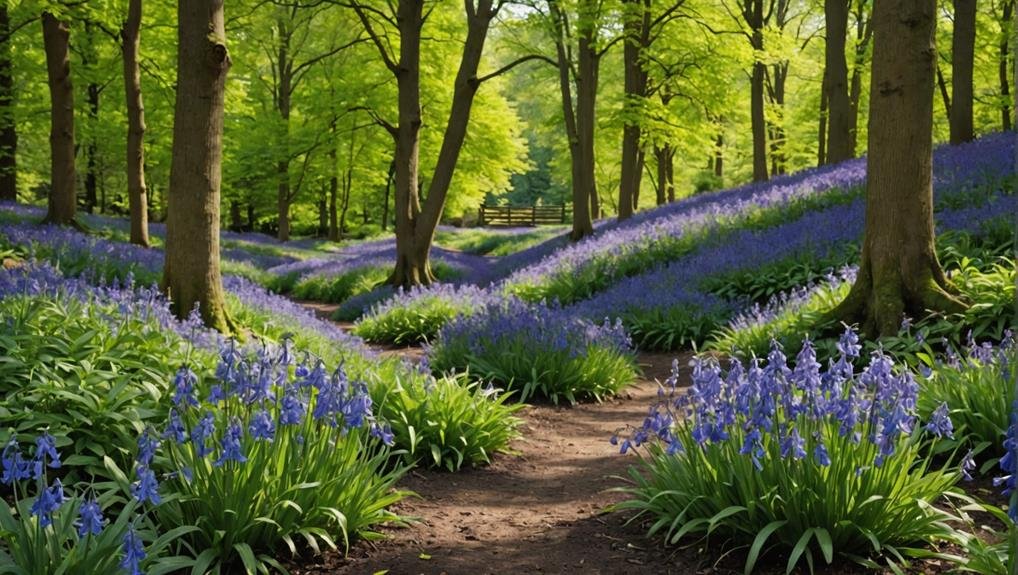
To cultivate the stunning beauty of bluebells in your garden, their specific growing conditions must be taken into consideration, reflecting the cool, damp environments of their natural woodland habitats. Bluebells thrive best in partially shaded areas, mimicking the dappled light of woodlands. Their soil requirements are essential; these flowers prefer moist, well-drained soil rich in organic matter, which supports their robust growth.
Here are four key points to keep in mind for ideal bluebell cultivation:
- Shade preferences: Bluebells favor partial to full shade, making them perfect for planting under deciduous trees or in shaded garden areas.
- Moisture levels: Consistent moisture is crucial, particularly during their active growing and blooming season in spring (April to May in the Northern Hemisphere).
- Spread rate: Bluebells are known for their ability to naturalize easily and spread rapidly, forming beautiful, dense carpets of violet-blue flowers.
- Native habitats: Understanding their native environments—cool, damp woodlands and meadows—can help replicate these conditions in your garden.
Cultural Significance
Revered across various cultures, the bluebell carries deep symbolic meanings of humility, gratitude, and everlasting love. In the United Kingdom, these enchanting flowers are legally protected due to their significance and rarity, making it illegal to pick or uproot them in the wild. This protection underscores their cultural importance and respect within regional traditions.
Folklore interpretations often portray bluebells as mystical flowers linked to fairies and magical domains. This whimsical association enhances their charm, making them frequent subjects in art, literature, and poetry. Historically, bluebells have been symbols of humility and thankfulness, reflecting their delicate and modest appearance.
In addition to their literary and artistic presence, bluebells play a significant role in traditional celebrations. For instance, they are a staple in May Day festivities, symbolizing good luck and prosperity. This historical symbolism of bluebells as harbingers of fortune further cements their place in cultural practices.
Typical Use in Weddings

Bluebells, with their iconic violet blue flowers, are a cherished choice in wedding floral arrangements for symbolizing sincerity and everlasting love. Their delicate, bell-shaped blossoms add a touch of natural beauty and elegance to bridal bouquets, centerpieces, and other floral arrangements, making them perfect for spring weddings. The abundance of bluebells in woodland settings during this season helps create a magical and romantic atmosphere, enhancing the overall aesthetic of the celebration.
Thanks to their versatility, bluebells can complement a variety of wedding themes, from rustic and bohemian to classic and whimsical.
When it comes to bluebell bouquet options, florists can incorporate these flowers in several ways:
- Bridal Bouquets: Bluebells can be the primary flower or mixed with other blooms for a more diverse arrangement.
- Centerpieces: Adding bluebells to table arrangements can enhance the natural and elegant feel of the reception.
- Boutonnieres: A single bluebell can add a pop of color and symbolism to the groom's attire.
- Ceremony Décor: Use bluebells to adorn the altar or archway for a cohesive theme.
To preserve their beauty, consider bluebell care tips such as keeping them hydrated and cool. This safeguards their freshness throughout your special day, embodying bluebell symbolism perfectly.
Alternative Flower Types
While bluebells are a stunning choice for wedding arrangements, other blue flower types such as cornflowers, delphiniums, and tweedia can also provide a beautiful and unique touch to your floral decor. These flowers offer varying shades of blue, from dark navy to light sky blue, allowing for versatile bouquet combinations that can cater to different themes and color palettes.
Cornflowers, with their deep blue hue, symbolize wealth, prosperity, and love, making them a meaningful addition to any wedding. Delphiniums, known for their tall spikes and vibrant blue flowers, represent cheerfulness and goodwill. Tweedia, with its delicate, star-shaped blooms in a soft sky blue, symbolizes peace and calmness. These symbolism interpretations can add a layer of significance to your floral arrangements, enhancing the emotional depth of your wedding decor.
For those interested in DIY arrangement ideas, combining these alternative blue flower types with complementary blooms can create visually appealing and personalized bouquets. Mixing cornflowers, delphiniums, and tweedia with white roses or greenery can provide a striking contrast and enhance the overall aesthetic.
These alternative blue flowers not only bring a pop of color and elegance but also allow for creative and meaningful floral designs.
